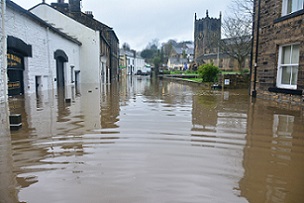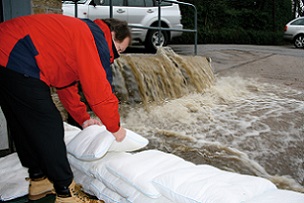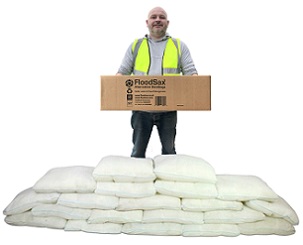 Flooded village by Chris Gallagher on Unsplash
Flooded village by Chris Gallagher on Unsplash
 A wall of FloodSax alternative sandbags can keep a torrent of floodwater at bay
A wall of FloodSax alternative sandbags can keep a torrent of floodwater at bay
 These 20 FloodSax sandless sandbags came from this one box that's easy to carry by just one person
These 20 FloodSax sandless sandbags came from this one box that's easy to carry by just one person
Who is responsible for sorting out flooding in your area?
People are often confused as to who should help them when flooding is forecast with many often contacting their local councils in a blind panic.
They often ask at the 11th hour ‘who is responsible for stopping flooding in my area?’
So here is the breakdown for which organisation has to deal with the different types of floods but be warned that none have to provide sandbags so, ultimately, protecting your home or business from flooding is your responsibility.
This was spelled out recently in a meeting of the influential Government Public Accounts Committee.
They heard that at the moment that an estimated 5.2 million properties in England are at risk of flooding and there are several different kinds of flooding.
These are river, coastal, surface water (when rainfall cannot drain away), sewer and groundwater flooding (where the water table level rises above ground). The Met Office’s UK climate projections indicate that climate change will cause more extreme weather events in the future and sea levels will rise. This, when combined with more homes being built in areas vulnerable to flooding will increase flood risks.
The Environment Agency is responsible for dealing with floods caused by rivers, reservoirs, estuaries and the sea.
But other organisations - mainly local authorities and county councils - are responsible for managing local flood risks. These include the risks of flooding from surface water, ground water and smaller watercourses such as smaller rivers and streams. Water companies are responsible for floods involving sewage.
The Environment Agency warns: “Don’t assume the authorities will provide you with sandbags in a flood emergency. It is the responsibility of property owners to take appropriate action to protect their property from flooding.”
Bradford Metropolitan District Council pulls no punches … and many other councils have the same strict policy. Bradford states: “There is no statutory requirement for a Local Authority to provide sandbags, nor to prevent a property from flooding. Many councils do not provide sandbags.”
Some councils recommend FloodSax alternative sandbags for flood protection which are a flexible alternative to traditional sandbags and are space-saving to store and quick and easy to deploy.
To find out why councils say FloodSax are better than traditional sandbags click here but Gosport Borough Council in Hampshire urges its residents to use FloodSax, saying it has evaluated the bags. The council adds: “FloodSax have many advantages over traditional sandbags, being easy to store and move, easy to use and, importantly, easy on the environment, having a significantly lower carbon footprint.”
FloodSax resemble large pillowcases until they come into contact with water. The semi-porous inner liner within FloodSax contains a special gelling polymer with hundreds of absorbent crystals which absorbs up to 20 kilos of water. This causes them to expand until they resemble a traditional sandbag in about seven minutes but in their dry state 20 fit into a cardboard box that one person can carry.
They are multi-purpose and flexible because in their ‘dry’ state they are used inside homes and businesses to soak up leaks and spills, often in hard-to-reach places (http://www.floodsax.co.uk/floodsax-indoors/)
More than 2.5 million have now been sold worldwide.